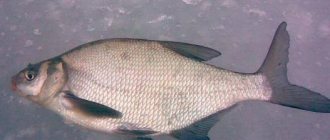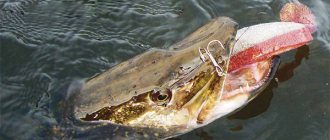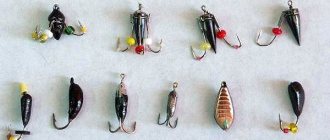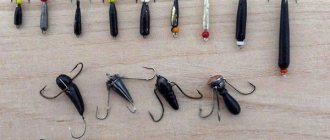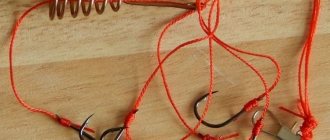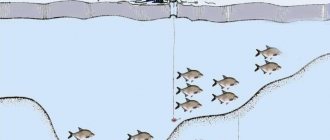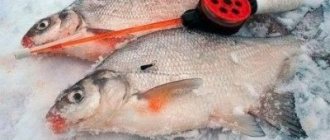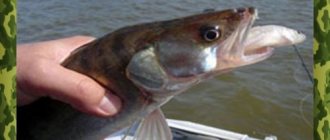Fishing with a reelless
Beads, rubber bands, cambrics and other things stimulate the ingenuity of winter fishing enthusiasts, who are completely indifferent to what the fish will be caught with, a live bait or a piece of inedible silicone. Although no, it’s not all the same. Such traditional bait as bloodworms still needs to be obtained and stored correctly, but with baitless jigs you can go to a pond at any time and not worry about whether there will be enough larvae until the end of fishing.
That’s why the rewinders find more and more fans with each new season. Even avid conservatives, looking at the successes of the moneyless people, are changing their views. They themselves begin to try to fish with a “bare hook”, fail, continue to experiment and, in the end, master the technique of fishing with small hooks, ants, droplets, bananas, oatmeal, goats and flies. In the list of catchable baitless jigs, the devil also takes pride of place. Why honorable? The answer is simple: fishing for devils in winter is very popular today.
How to properly catch bream with a devil
The effectiveness of winter fishing for bream on the devil depends not only on correctly configured, balanced gear and a well-assembled set of jigs. The fisherman needs to learn to determine the time and place of his fishing. You need to master the technique of presenting bait, delve into other subtleties and nuances of fishing.
We recommend reading: Catching chub on the river in winter
Educational video about finding and catching bream with a devil.
Time and place of fishing
You can catch bream in winter day and night. During daylight hours they search for it, exploring promising areas. In the dark, they set up a tent, drill several holes and fish stationary. As a rule, weighty and trophy specimens are taken after sunset.
You need to look for bream in deep areas of the reservoir. The fisherman simply must examine:
- channel dumps;
- pits, entrances and exits from them;
- edges and slopes;
- local pits and hills;
- long ditches and ravines.
The maximum activity of bream is observed in December during the first ice. He is active and eagerly responds to the offered bait. In the dead of winter, the fish’s appetite decreases, it moves little and tries not to waste energy. Steady biting resumes at the end of winter.
Do I need bait?
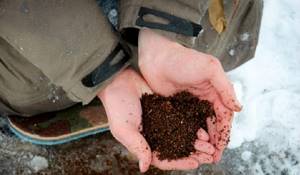
The use of bait when catching bream with a devil is in most cases justified. It allows you to attract fish to the fishing point and keep it there for a long time. Sometimes the use of a bait mixture collects a lot of small things under the hole, which interferes with a full-fledged hunt for trophy specimens. Small bream, silver bream, and roach begin to take over. Therefore, many factors must be taken into account when choosing fishing tactics and the composition of the feed.
Please note! The bait should not be very dusty, otherwise small things are guaranteed to accumulate at the fishing point.
The simplest and most effective bait consists of small feed bloodworms mixed with soil. It is driven into a special dump truck feeder, lowered to the bottom and opened there, creating a spot at the fishing point. The movements of mosquito larvae and mud from the ground attract the attention of the bream; it approaches the fishing zone, where the angler feeds the devil.
Also, fishermen without bait often use live mormysh (amphipod crustacean). It can be lowered to the bottom with a special feeder, or, if there is no current, it can be thrown directly into the hole, slightly muffled.
Naked devil or with a nozzle
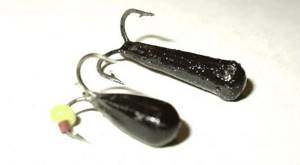
The devil on a bream can be naked, but it is much more effective to decorate it with an additional movable element. Hooking a jig on the hook will attract the attention of the fish, help provoke it to bite, and act as a point of attack.
We recommend reading: Fishing for rotan in winter
Some of the baits for devils include:
- multi-colored cambric;
- beads of black, white, red, yellow or green;
- sequins.
Some fishermen hang several links of a thin chain or tie a red thread, Lurex, or put on small silicone balls.
When stationary fishing, especially at night, you can attach fresh bloodworms or small earthworms to the devil’s hook. In addition to it, the larva of the burdock moth works. You need to take care of its availability in advance, preparing it in late autumn.
Origins
The jig appeared on the fishing horizon at the turn of the 70s and 80s and immediately won many admirers. It is not known for certain who invented it and why they called it the devil. But there are serious reasons to assume that the devil jig, like the vertical spinner (now commonly called a balancer), came from the eastern regions of Russia. Its prototype was a bait called a “bug,” which was successfully used by fishermen on the Sea of Okhotsk in the middle of the last century. The marine origin of the devil is indirectly confirmed by the fact that it was sea fishermen who were the first to fool fish (deceive them with inedible fish).
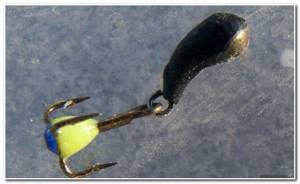
How to make a devil on bream with your own hands
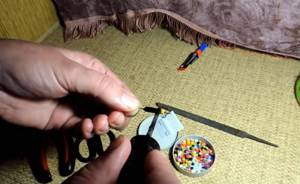
Experienced fishermen make their own devil at home. To do this you will need the following materials and tools:
- copper wire;
- hooks or small tee;
- lead;
- aluminium foil;
- wooden plank;
- beads;
- vice;
- file;
- needle file;
- sandpaper;
- soldering iron;
- pliers;
- wire cutters
First, prepare the hooks by biting off the ears and soldering the shanks together. Then they form a cone from foil, fix it on a wooden board, install a tee and an eyelet for attaching to the fishing line, and pour in molten lead. After waiting until it hardens, they process the workpiece with a file, needle file and emery, giving it the necessary cleanliness. They equip the little devil with beads or pieces of cambric and, before going out to the pond, test it in a jar of water.
Video about making devil bait yourself.
Tackle for catching devils
It must be said right away that a jig is unlikely to work if you take a float rod, remove the bite alarm from it and tie a reelless bait instead of a hook. It would be too easy. A number of requirements are put forward for fishing tackle with such bait.
There are three main ones:
- high sensitivity (provided by the softness of the nod);
- the ability to create attractive low-frequency vibrations (achieved by adjusting the length of the nod);
- reliability (must withstand large fish).
⚓️ Fishing rod
To assemble one, you will need a fairly long fishing rod (up to 450 mm), allowing you to do full wiring while sitting on the box, and not hanging over the hole, hunched over. It is advisable to equip it with an ergonomic handle, with which your hand will not get tired and it will be easier to work with this type of jig.
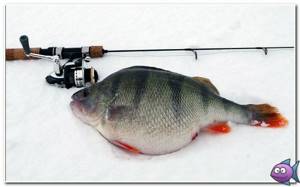
⚓️ Reel
The fishing rod must be equipped with a reel, open or closed. Thanks to this element, you can quickly reel in the tackle while actively searching for fishing spots, thereby saving precious time. The larger the diameter of the spool, the better, since the line wound on a small spool turns into a spiral. It will level out only after 5-6 wiring.
⚓️ Nod
The defining element of the tackle is the nod. For winter fishing with devils, experienced fishermen recommend using nods of at least 200 mm in length with the ability to adjust this parameter. Using an unusually long nod, you can force the bait to play at a low frequency (no more than 2 vibrations per second), while the amplitude will be quite high. That is, the jig will move smoothly, rhythmically and seductively. For fishing in fast currents, at significant depths and in windy weather, the length will have to be shortened; for such conditions a more stable nod is needed.
⚓️ Fishing line
The fishing line is selected taking into account the same conditions plus the expected size of the prey. As a rule, this is a monofilament with a cross-section from 0.10 to 0.14 mm. The best choice would be a stiff sinking line, which is more suitable for those relatively deep depths where the devil is usually used. If it is soft and buoyant, this will greatly complicate the angler’s contact with the bait, and therefore will negatively affect its game. You can use braid, which adds confidence when fishing for large prey, but in this case you need to be prepared for the fact that in the cold it will first take on water, then become covered with an ice crust and freeze on the reel. This primarily applies to cheap braided cords without special coating.
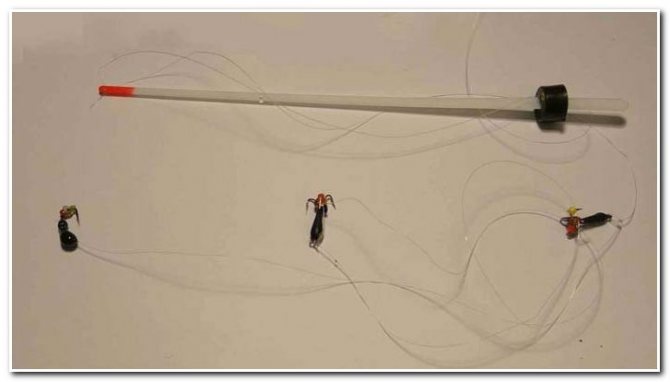
Equipment Features
The fishing rod for this kind of fishing is different from the usual one with a jig. The following requirements must be met: certain requirements.
Rod
Basic requirements for a fishing rod:
- The fishing line installed on the rod should have a thickness of 0.08 to 0.14 millimeters.
- The presence of a coil is a must.
- The rod should have a comfortable handle and an acceptable light weight.
- The nod must be installed elongated and with the required stiffness coefficient.
These requirements are determined by the characteristics of fishing for devils. Winter fishing conditions usually do not involve sitting in one place for a long time. You will have to look for fish, which is why the fishing rod should be easy and quick to assemble and disassemble.
In this case, a fishing rod and reel is simply the best option. Also, snow does not stick to the reel in winter, which is also of great importance.
Nod
The nod should be, as already described above, a special elongated one. This design of the nod is necessary to ensure the required amplitude of vibration of the bait. Also, a long nod smooths out incorrect movements of the novice fisherman’s hand.
The nod material should not change its performance properties under the influence of negative temperatures. The most popular are metal nods, but what about lavsan options with a length of 15 - 20 centimeters.
If necessary, the nod can be bent at the required angle. This is done to specifically adjust the fishing rod to suit you.
fishing line
A line with a maximum cross-section of 0.14 millimeters is used to transmit vibrations from the rod to the bait. If you use a thicker fishing line, the quality of vibration transmission will noticeably decrease. In addition, a thick fishing line will be visible to the fish, which will negatively affect the outcome of the fishing.
According to the design of the fishing line, it can be:
- Wicker.
- Monoprofile.
You can use any at the request of the fisherman.
It is precisely because when using the devil tackle, the fishing rod is equipped with a thin fishing line, and there is no possibility of installing a leash, it is impossible to catch a pike with this tackle. The toothy predator simply cuts off the devil when attacking, because it has very sharp teeth.
From the stories of experienced fishing masters using such gear as the devil, it is known that of the predatory fish you can catch perch and pike perch with it, but no one has caught pike.
Variety of "devils"
There were so many jigs of this type that they were divided into two groups: the devils themselves and another representative of the dark forces - witches. The main difference between a witch and a classic devil is the larger number of hooks. She has not three, but four. All this “evil spirits” is replete with different shapes, colors and additional elements or, as winter fishermen call them, replantings.
The shape of the jig is determined by the production technology. It can be drop-shaped, almost spherical or elongated (cigar-shaped). Each of them had its own adherents who fiercely defended their position. Fans of catching fish with round-shaped devils claim that they are more similar to the natural food of underwater inhabitants, namely bugs. Well, fans of long jigs put forward their arguments. The most significant is the relatively easy removal of bait from the fish’s mouth.
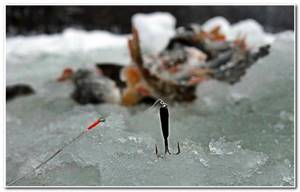
There is an opinion that the color of the devil does not have much influence on the number of bites. The classic black borer was and remains unrivaled, and attempts to make it more catchy with the help of bright colors or sparkles are rather subjective. To date, it has not been proven whether such deviations from the classics affect the fish’s bite, or whether they are able to stir it up. If it is not under the hole or it is in a state of suspended animation, even play with a gold-plated jig, you still won’t get a bite.
It is advisable to make refills from a soft material, for example, fine-pored rubber. Each jig hook is equipped with a miniature piece the size of a millet grain. But the use of hard cambrics has a bad effect on the grip of the bait. Often they slide towards the hook's sting and at the moment of hooking do not allow it to penetrate deeply into the soft tissues of the fish's mouth.
An interesting solution was proposed by fishermen from the Moscow region. On one of the devil's hooks they hang a narrow strip of thin rubber cut from an inflatable ball. Approximate size – 12 mm x 2 mm. A bait equipped with such a microtwister shows excellent results, including during periods of total lack of biting.
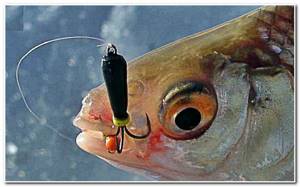
Devils for perch
Devils for catching perch are reelless jigs, relatively large, spindle-shaped with a triple hook. The main critical feature of such a bait is strict centering relative to the vertical. Devils work and attract fish with a clearly defined vertical play without horizontal deviations. The main method of wiring is intermittent dotted rises and falls in various variations, similar to the movement of an amphipod crustacean in water. Striped loves low-amplitude, high-frequency play and dribbling. In the wilderness, the pace of the game slows down, but the basic law of mothlessness - monotony and the absence of failures - is still followed.
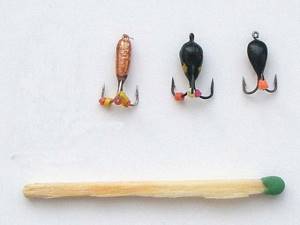
Catching perch in winter with a devil is possible using any size and shape of such jigs. But for targeted hunting for striped fish, it is better to use short, “bellied” baits. Perch reacts better to them. If during periods of activity you can tempt a predator to use any form of bait, including elongated “bream” baits, then in the middle of nowhere short and plump decoys work well. An article about catching perch with a reelless reel.
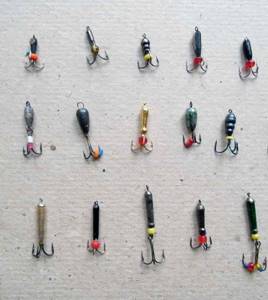
Features of the devil's use
The key to successful fishing with any reelless bait, in particular with the little devil, is a quick search for a school by fishing in promising places. We are talking about areas with anomalies of the bottom surface, such as slopes, edges and other significant and minor differences in depth. On the river, these are most often found on turns and sharp bends, and on an unfamiliar lake, numerous holes drilled by other anglers help determine a promising point. You can check ready-made ones or drill your own series across a river bend, arranging the holes in one line. The optimal distance between them is 5-6 meters. Fishing should begin from the deepest point, moving towards the shallows. You shouldn’t stay on one hole for a long time; after 7-8 runs you can move on to the next one.
The basic animation when fishing for devils in winter is two or three light blows of the bait on the bottom, followed by a smooth rise to a height of up to half a meter, accompanied by rhythmic oscillations of the nod. Usually the bite occurs in the first 10-15 cm. If the fish does not respond, it is advisable to speed up the pace of the next retrieve. In addition, at the top point it is recommended to make a short stop of no more than a second and perform a control sweep. Quite often, a passive fish simply accompanies the jig, pokes its nose at it, but does not want to take it. If the hook is successful, the hook will be in her lower lip.

Driven by hunger, silver bream and bream, as well as schools of large roach, often appear in areas that are absolutely flat as a board, where floaters love to fish. The latter generously feed their holes, so positioning themselves next to them and fishing nearby (even two meters away) would be a big mistake. It is better to try to determine from which side the fish are approaching their holes, find this path and get a decent catch for your efforts.
Catching winter perch using the devil: searching for “sailors”, strategy, fishing
Small perch stay in the coastal zone almost all winter, among vegetation, small branches, cattails and bushes. Less often, it can migrate to coastal edges in search of sources of food and oxygen.
When catching medium and large striped robber, everything becomes more difficult, but also more interesting. It changes its sites depending on many factors - the specific period of winter, weather conditions, type of reservoir, atmospheric pressure and others. The main tactics of a successful bass fisherman when fishing with baitless jigs, in particular with devils, is an active search and parallel exploration of the reservoir.
Where to find perch when fishing with a reelless bait - devil
You can catch perch with the devil in any body of water and at almost any time of winter. But, of course, its parking places will change. And the first task of an angler is to know where to look for perch...
It would be incorrect to say that the perch moves randomly around the pond. This thesis is not fundamentally true; with such an approach, especially on an unfamiliar body of water, the fisherman is doomed to hopelessly catching single specimens without a system. Yes, perch is characterized by migration during the freeze-up, but all its movements are subject to instincts and external conditions.
Depending on the season - winter migration of striped
The migration of perch is determined by weather conditions (pressure is paramount in winter), the presence of oxygen, the movement of the food supply, as well as the nature of a particular reservoir.
On the first ice, as soon as the ice has become and for 4-6 weeks after, the perch continues to stay near its favorite autumn places. Near the flooded snags and bushes near the shore. It can stand on the shore edge and fall from it into the depths. The largest individuals stand at the exits from the pits.
When catching small devils, by-catch often includes roach, bream, and sometimes crucian carp.
At the beginning of freeze-up, perch continues to actively move and feed, gaining fat before the dead winter. It is also worth moving for the winter angler, anticipating and anticipating the movements of the predator. The holes are scattered in a checkerboard pattern at a distance of 10-15 meters in order to quickly cover a promising area.
And having found it, hit the target clearly, without wasting time on secondary tasks.
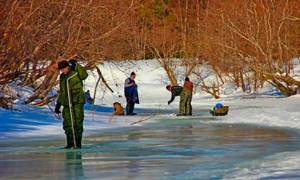
The coastal zone among fallen trees and bushes is promising for perch fishing at the beginning of winter (and more or less safe)
In the wilderness, everything is somewhat different. At this time, the striped one rolls down to deeper places and falls into a kind of suspended animation, but not one hundred percent. In January-February-early March it is worth looking for changes in depth, channel and coastal edges, underwater anomalies (islands, patches, snags, sudden changes in stream).
In this case, the holes are drilled more closely at 3-6 meters from each other. And the most beautiful points are drilled even more tightly.
At this time, all possible animation methods and types of devils are used. In order to stir up the passive predator as much as possible using all possible methods. Passive bass does not equal dead. He can be brought out of the frozen result and forced to grab the jig.
Changing the devil to the smallest size, up to 1-2 grams, often gives the result.
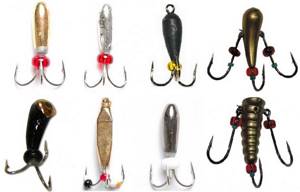
Important! During extreme winter conditions, it is worth paying attention to places with maximum oxygen saturation. Places of confluence of rivers and streams, near discharges of hydroelectric power stations and dams, near artificial and natural wormwood, among thickets of reeds and other above-water hollow vegetation.
At the end of the freeze-up, when the ice begins to gradually melt and areas of open water begin to appear in the current, the perch begins to move and become active again. It emerges from the depths and begins to hunt in half the water, gradually approaching the early winter moorings.
Large water area - where to go?
On large bodies of water (reservoirs, lakes, river bays and rivers themselves) it is much more difficult to find a promising point. Especially without knowledge of the reservoir and a local guide. It is clear that wandering aimlessly through such territories is futile. Therefore, we are looking for any landmarks - changes in depth (determined by a depth gauge and the color of the ice), anomalies on the bottom (banks, bends in the bottom, shallows against the backdrop of great depth), any snags, fallen trees, changes in the direction of the current, and also - be sure to look for accumulations fishermen The latter is not shameful and even useful.
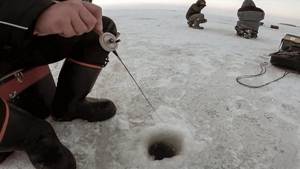
In large and unfamiliar waters, it is worth paying attention to sedentary old people/old-timers - often, they are the most important litmus for the presence of fish. But we don’t get impudent and don’t drill closer than 10-15 meters.
Snags, fallen bushes and branches are a perch’s stopping point throughout the winter
Medium-sized and large perch - humpback fish, of course, are in snags and at depths. In such places, when fishing in the current, it is worth drilling holes behind the snags downstream - this is the most promising method of fishing in such points.
You should prepare 8-15 holes in advance and then process them starting from the first.
Moreover, in this case, one can interpret the well-known proverb: “the fisherman’s legs and arms feed”; you should not linger for a long time on one hole. If there is no bite for 5-10 minutes with several types of animation, you need to move along pre-drilled holes. And then look for a new promising point.
It should be noted that when the water level drops, the perch will also move to deeper places - such situations are observed in reservoirs, rivers near dams, lakes connected to rivers.
Advice! It is important to start exploring the reservoir in the summer, if possible. It is in the summer that, with the help of your eyes, experience, spinning rod and echo sounder, you can identify promising spots for perch, including in winter.
Strategy and tactics of a fisherman's actions on a reservoir when catching perch with devils
Once on the pond, we determine promising perch anchorage points (see above) so as not to waste time and effort searching throughout the entire water area. We study the relief, characteristic turns and bends of rivers, depth differences, edges, holes using a depth gauge. We designate snags, fallen trees and areas near them.
If the reservoir is familiar, we remember summer tasty points and superimpose them on winter realities.
We drill starting from the very shore and towards the depths in a checkerboard pattern with a number of 8-15 holes at a distance of 6-8 meters from each other, covering the entire marked area. The deeper, the larger the devil is used so that it can be adequately animated.
We start fishing from the first hole, use 2-3 animation methods for 5-7 minutes. If there are no bites, we move on to the next one. We won't stay any longer.
If there are pokes, but the fish is not detected, or the bite is very sluggish, then the perch is passive. To stir it up, you should change the devil to a smaller one/a different color and shape/take a jig with a free hanging tee, change the animation to a more active and daring one, or, conversely, more impressive.

Having fished the first sector and not getting any results, we change the point to a radically different one. Let’s say we were standing near a coastal snag, looking for underwater changes in depth, standing on a channel edge, moving to a bend in the river, etc.
If there were holes with a catch, it is worth marking them. Often a new flock takes the place of a captured one, occupying an empty niche under water.
Influence of weather conditions
The beginning and end of winter is the time for perch to actively bite on reelless jigs. At this time, it is worth actively looking for it throughout the day, often regardless of the weather. But it has been noticed that the bite is more active at times when the weather, and therefore the atmospheric pressure, is stable for at least 3 days.
In remote areas, it is worth selecting thaw days with low pressure whenever possible.
You should not go to the pond when the weather changes. A sudden change in wind is also not a plus.
The type of devil animations that striped robbers like
After a correctly defined point, the first place comes to the correct presentation of the devil - animation.
It is worth considering this point that in most cases the striped robber prefers high-frequency and small-amplitude play, with sharp jerks, chaotic steps, etc. Except in cases of deaf winter and lack of oxygen. On days like these, it’s worth trying fishing, like for bream - slow, impressive with a lot of pauses.
So, basic wiring for an active perch:
- The classic “step” - the mothless fish lowers to the bottom, gives a micropause and then rises in steps of 5-20 cm to 50-60 cm from the bottom. The size of the steps, the sharpness of the rise and its uniformity vary and are selected on the reservoir.
- Dotted strictly vertical rise.
- Uniform or accelerated throwing of the devil up with chaotic or measured dribbling of the jig.
- Dribbling on the steps . A step is made, but instead of a pause on the steps, the jig shakes slightly with the help of the hand or by striking the fingers of the left hand on the rod's whip.
- Lifting and dumping . Uniform rise and release of the nozzle into free fall. The downside is poor bite control.
- Interpretation of the previous options - toss to x, reset to half x . Figuratively, we throw the jig 30 cm, drop it by 15, throw it another 20, drop it by 10 and so gradually bring it to the minimum difference and lower it to the bottom. It is convenient to actively fish a wide range of depths.
- Chaotic impacts on the bottom . The devil walks near the bottom, with impacts against it and a parallel rise of turbidity. A very workable option for perch that grazes near the bottom.
- Cutting "saw links" . The step is not made vertically, but with jerks to the sides at an angle to the vertical. Although the devil is initially a vertically playing jig, this option gives results against an active predator. The jerks are chaotic in different directions. The more active the fish, the shorter the pause.
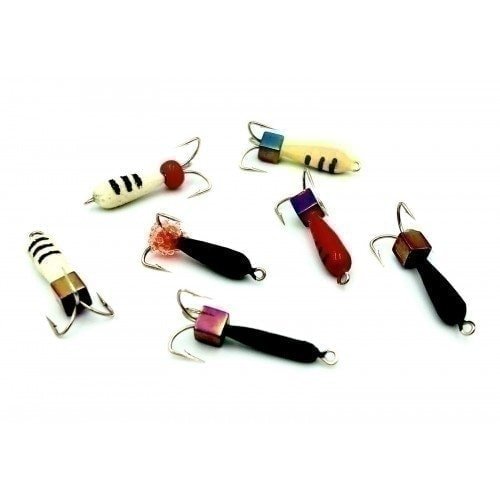
For a passive sailor, different options for lazy, imposing animation will work:
- stirring at the bottom, almost without detachment from it;
- the slow rise of the devil, with a long pause at the end point;
- pulling along the bottom, if possible (opening hole or wide hole, clean bottom, relatively powerful tackle);
- shallow dribbling almost in one place.

The frequency and amplitude of the devil’s play can also be set by changing the angle of the fishing rod to the horizon. The sharpest and highest-amplitude jerk can be set by holding the fishing rod vertically with the nose in the hole. Minimum - vertically upwards. But, logically, these are two extremes that fishermen do not use. Most often, the entire game with the devil takes place in the range of 45-135 degrees relative to the horizon. The logic is still the same, the more we tilt the rod up, the less sharp jerks will be given to the devil during animation and vice versa.
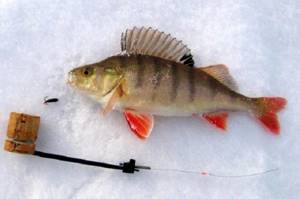
While fishing, you sometimes have to drill hundreds of holes and walk a single kilometer on the ice. Therefore, we recommend having a comfortable drill with sharp knives, comfortable clothes and shoes, and a minimum of equipment.
It's better to see once
Video clips that reveal important practical aspects of catching perch with the devil in winter.
Seasoned perch on the devil:
Catching perch with a devil on the first ice:
Helpful advice
Many winter fishermen do not have the opportunity to go fishing on weekdays, so on weekends they have a blast. That is, they pour kilograms of bait into the water, thus hoping to attract more fish. If you walk through their holes on Monday, you can get fantastic pleasure from your favorite activity. No-attachment jigs have long proven their effectiveness; they can be used to catch any fish - from rotan to whitefish. It is not surprising that fishing for devils in winter has become one of the most popular types of fishing today.
Search and catching tactics
Winter fishing for perch with devils is carried out according to all the canons of ice hunting for striped predators, observing the features of baitless fishing. In winter, fish stand quite compactly in their favorite places, without moving far from them. Therefore, the most important thing is search. This point has already been discussed many times in articles on our website. When the predator is finally found, it’s time to use the gear. The success of fishing is ensured by the correct equipment and skillful play. Even in the dead of winter, the devil can activate a completely passive predator. During periods of passivity, it is easier to lure perch to small bait. Therefore, reconnaissance tapping of holes with a devil is often more effective than trolling.
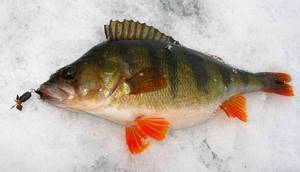
Devil fishing line
Many devil fishermen have a minimum line thickness of 0.15 mm, and when they are lucky enough to run into a fattening school of pike perch or large perch, they use a line of 0.2 mm or even thicker.
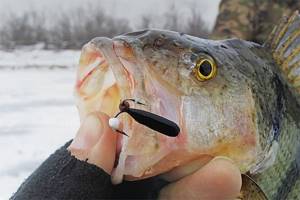
Naturally, you can’t put a light bait on such a “rope”, since you won’t be able to play with it normally, so they use heavy devils weighing 1-2 g. Of course, a sufficiently powerful tackle for winter does not mean at all that it is rough and insensitive. After all, quite a lot of other equipment elements are used to make it harmonious and obedient.
You can choose a fishing line that is rigid and preferably sinking. Rigid fishing line tangles much less in the wind. In addition, it has little stretch and more clearly conveys bites from the depths. For the same reason, it is preferable to use a sinking line. The lack of buoyancy reduces the friction of the fishing line on the water, thereby improving the game of the reelless fish, and careful fish bites are much more noticeable.
Choosing a Rod and Reel
For a fairly powerful tackle and, accordingly, a heavy jig, devil fishermen try to choose not a “universal”, but a specialized nod for a strictly defined weight of the jig. The universal, as we know, is often the enemy of the good. In powerful gear, so that it does not turn into rough, all elements must strictly correspond to each other and work like a clock.

Having tried many materials, a considerable part of fishermen opt for a steel watch spring. For greater efficiency, grind it into a cone. The length of the working part of the nod is about 10-16 cm. Small passage rings are soldered on the tip of the nod (sometimes in the middle). If the ring freezes in severe frost, then lubricate it with Vaseline.
Some fishermen use cork handles on fishing rods (can be cut from an old spinning rod) 20-25 cm long. They also use a vinyl plastic whip of this length. A plastic reel with a spool with a diameter of 5 cm is mounted in a spinning reel seat. Such a long fishing rod is very convenient when fishing for pike perch. They can lift the bait as high as possible from the bottom soil (a frequent requirement for the devil), and hook it with a wave of the brush even at a considerable depth.
The reel may seem too primitive, but attempts to use multipliers were not successful - these reels are too capricious in the cold, and it’s a pity to throw such an expensive thing into snow or ice.
Variety of devils
There are a huge variety of devil jigs. Fishermen with considerable experience, having tried almost all known designs, came to a paradoxical conclusion: you can fish with anything, as long as the tackle is balanced and, first of all, the nod is correctly selected. But some devils also have disadvantages, or rather features.
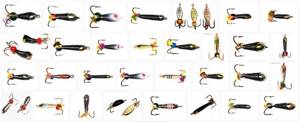
For example, there are baits hanging on a fishing line at an angle that sometimes reaches 45 degrees. They make it easier to diversify the game, and the number of empty bites is significantly reduced. But such a bait regularly clings to the lower edge of the hole, and this often ends in offensive derailments and line breaks.
The hooks on the devils usually protrude beyond the body of the jig, but there are models with non-protruding hooks. Protruding hooks are more reliable when hooking, but it is impossible to fish in snags with a jig with such a hook. But this is one of the favorite habitats of large pike perch. Straight-hanging devils, in which the small tee does not protrude beyond the body of the bait, are capable of working without hooks in the most difficult conditions, but there are quite a lot of derailments from them... The choice is up to the angler.
